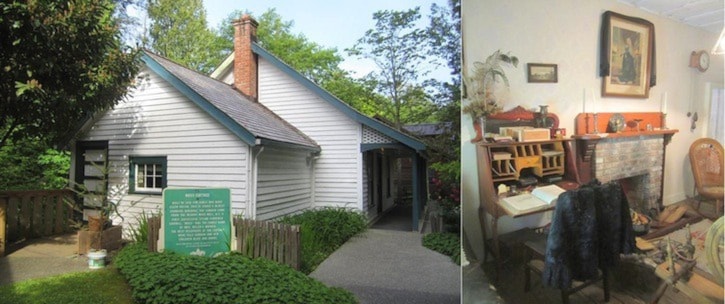Moss Cottage is the oldest standing pioneer home west of Victoria and was built in 1869/70 by James Welsh (relative to the Muirs). Today the cottage is situated on the museum grounds, but it was originally constructed near Woodside Farm where the Sooke Baptist Church is today.
James built the cottage for his wife Mary Ellen (nee Flynn) and they lived there for 10 years before she died in childbirth in 1880. Mary Ellen had named her home “Moss Cottage” in memory of her mother’s family name back in England. The cottage was built using lumber from the Muir Mill, which was B.C.’s first successful steam-powered sawmill. After Mary Ellen’s death, the cottage was occupied by Matilda Gordon (Aunt Tilly) and her two children Alice and Harry. Matilda was James and Mary Ellen’s niece and the granddaughter of the original pioneering Muirs.
Throughout the 1900s the cottage was passed down through James’ kin and was given to the Sooke Region Museum in 1977 by Ernie Welsh (grandson of James). Since its reconstruction on the museum grounds, the cottage has been restored and maintained by the Sooke Region Historical Society. The most recent repair to the cottage is a new roof in 2012. Today the inside of the cottage takes you back to the turn of the century in 1902. In this year, Matilda has lost her husband Jack Gordon to consumption and she is raising her two children on her own.
Inside the cottage you will find four distinct rooms: The kitchen, parlour, children’s bedroom and Matilda’s bedroom. Each room is completely furnished using a variety of donations and artifacts to bring this early 1900s era to life. The Moss Cottage kitchen is a very special place for visitors as the various artifacts, meat and herb props, furniture, and familiar smells really evoke memories. The kitchen is filled with vintage supplies such as butter paddles, cake tins, washboards, spice tins, numerous pots and enamel dishes, an egg beater, a metal cream skimmer and furniture. Also in the kitchen are utensils from Sooke’s Belvedere hotel (burned down in 1934). One of the most stand-out artifacts in the kitchen is the 1896 Albion wood and coal range stove (1975.001.001a-q). The iron stove, donated by Joe Vowles, consists of numerous parts including a main stove, warming oven, thermometer and detachable cooling rack. Visitors will also notice a beautiful large wooden cabinet that houses many of the kitchen display’s spices and food tins, utensils, dishes and jars (1980.003.001a-f). The wooden cabinet, donated by Mrs. Kay Maughan, has a hutch that attaches to a buffet with multiple drawers. The hutch has two shelving compartments lined with metal and doors fitted with glass windows.
The parlour is the equivalent of today’s family room. It has a fireplace, book shelf piano, spinning wheel, writing desk and chaise lounge. Other artifacts in the parlour include a gramophone, phonograph, writing box, prints and velvet framed photographs, autoharp and a kerosene lamp. One of the most historically valuable artifacts in the parlour is the piano (2014.FIC.359). The piano belonged to the Welsh family and was donated to the museum by Helen (Welsh) Yost. Visitors often ask about the portrait hanging over the fire place. This is a portrait of Queen Victoria and there is a black scarf draped over it because the household is mourning her death (1901). The portrait was donated by Brock Robertson in 1978. Also in the parlour is a tea cloth made by Kitty Gordon (of Gordon’s Beach), who was Matilda’s sister-in-law. A black embroidered coat hangs on the desk chair to show that Matilda is also mourning her husband Jack. For school tours and events in December, a Christmas tree is set up in the parlour and Moss Cottage is decorated for the holiday season.
Both bedrooms in Moss Cottage represent how Matilda and her children were living and what their décor and personal taste may have been. The children’s bedroom has blue and cream striped and floral wallpaper, two beds with patchwork bedding, a dollhouse, books, toys, and candles for light. Laid out on one of the children’s beds is a book belonging to Alice titled Mother’s Stories (1991.021.001). Inside it says, “Douglas R.N. Muir a birthday gift from Mr. Mitchell, Victoria 1888” and “Alice Mary Gordon a Christmas gift from Douglas Muir December 25, 1903.” Also in the children’s bedroom is a hot water bottle (or “pig”) that would have been placed under the blankets at the end of the bed for warmth.
In Matilda’s bedroom is pink floral wallpaper, a large wooden bed, dresser, sewing table with projects and a washing station. There are clothing items laid out on the bed, shoes lined up on the floor and vanity items on the dresser. Also in the bedroom are fishing rods hanging on the wall, a kerosene lamp and a jewelry box. During tours, a tour guide will point out the cotton mattress as it is stuffed with horse hair (1984.048.001). There is a large tear in the mattress that allows visitors to see the horse hair inside.
There is Muir, Welsh and Moss Cottage history throughout the museum. In the pioneer and first settlers’ display are two silver cups that belonged to Harry and Alice. Harry’s cup has a very ornate handle and “HLG” engraved in the middle of it. Alice’s cup has floral designs and the handle has a small cat figure on the top and a bird on the bottom. Both cups are very small, ideal for children’s hands. Character tours of Moss Cottage are available throughout the summer and cost $3 per adult and $1.50 per child. On Sunday June 28, at the museum’s annual Open House, tours of Moss Cottage are free of charge.
Brianna
Shambrook Collections and Exhibits Manager
Sooke Region Museum
